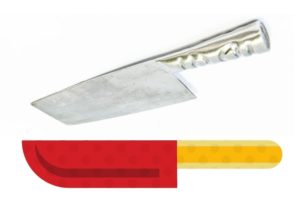Are Shun knives worth it?
Shun is a brand of traditional Japanese knives, popular for their thin, lightweight blades made of high-quality tempered steel, many of which feature beautiful Damascus patterns.
Owned by the Kai Corporation, Shun Cutlery has been manufacturing knives in Seki City for over 100 years. This region of Japan has long been known for its skilled craftsmen who have been making swords, knives, and other cutlery here since the 13th century.
The spirit of these sword smiths lives through each of the knives they produce. Handcrafted, Shun knives require dedication to get the finish.
They still follow the blade-making traditions of the past while using more modern Japanese super-steels to increase performance for the future. For the above reasons and more, many consider Shun knives to be the best Japanese kitchen knives.
Table of Contents
Popular Shun Knife Lines
Shun Cutlery is one of the most popular producers of Japanese-style kitchen knives in the world. They currently produce 7 main knife lines that are sold in the United States.
Each range is distinguished by its level of quality, its level of price and the clientele it targets, ranging from the mid-range to the high end of the kitchen knife market.
Here is a list of lines with details and our review on each to help you in your search for which Shun knife to buy.
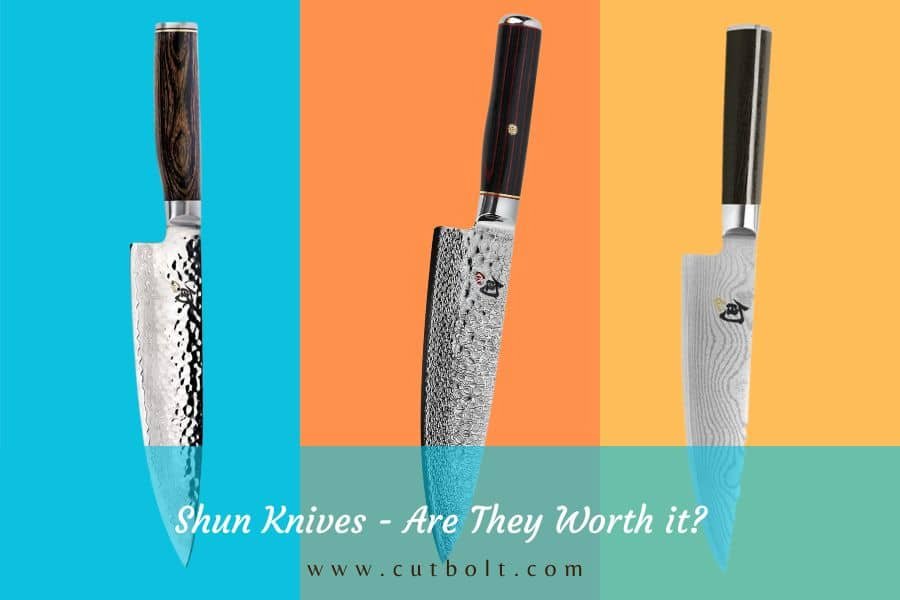
Shun Sora
Sora is the least expensive Shun knife collection. It is made of a three-layer VG10 steel cutting edge and uses polished Japanese 420J stainless steel on the upper part of the blade.
This composite blade technology places the most expensive material only where it is needed. And, it’s on the edge that retaining sharpness matters.
In an ongoing effort to keep costs down and enable more home chefs to afford Shun knives, the Sora uses a textured PP/TPE plastic handle that has an excellent grip and requires very little maintenance.
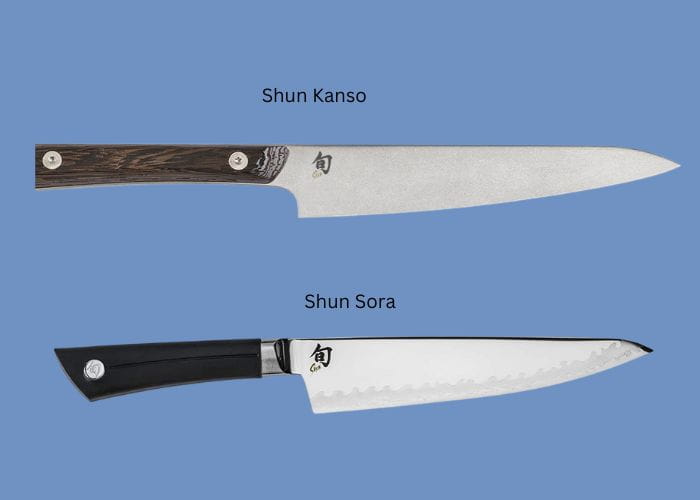
Shun Kanso
We love the unique look of the Kanso collection, the continuation of the Shun knife lines. It uses very simplistic design features and only focuses on what is important, which is a sharp blade and good balance.
Kanso knives use Japanese AUS-10A steel for the blade. It conceals scratches very well thanks to its “Heritage” finish. The full handle design strengthens the knife and provides a solid base for the tagayasan wood handle.
Tagayasan is very dense and durable and makes an excellent material for wooden handles.
Shun Classic
The Classic Series is one of the most popular knife lines and is the cheapest option that uses Shun’s proprietary VG-MAX Super Steel for its cutting core.
This core provides a sharper and more durable edge. It’s also wrapped in 34 layers of folded Damascus steel on each side, making it stain resistant.
Additionally, the Pakkawood ebony fretboard has an asymmetrical D-shape, which gives the user a very ergonomic and comfortable design.
These knives are specially designed for a right-handed chef. We’ve seen mixed reviews on left-handed comfort, so if you’re left-handed, we’d recommend the Premier series.
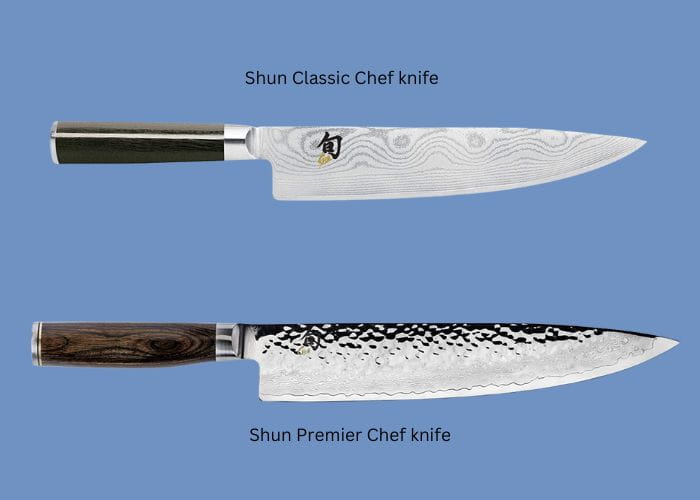
Shun Premier
Traditional Japanese artisans handcraft Shun’s Premier Series knives. It is also one of their most popular lines. Made with a VG-MAX steel core, the blade is covered with 34 layers of hammered Damascus steel.
The hammered texture produces dimples that don’t look like some hollow ground edges you’ve probably seen on other kitchen knives.
This reduces the effects of friction and prevents food from sticking to the blade when in use.
The Premier Series handle is walnut-colored pakkawood, symmetrically shaped, therefore ambidextrous, meaning it was built for either right- or left-handed chefs.
Shun Blue Steel
The Shun Blue Steel collection doesn’t have tons of options and is very exclusive. It can even be hard to find sometimes.
Similar to the Dual Core, the Blue Steel knives have an octagonal-shaped Pakkawood handle (very traditional Japanese look) and come with their own saya.
Unlike any other Shun knife, Blue Steel knives are made with plated Blue Steel (which should have been obvious from the name). It is a very high-end blade material.
Note that it patinates over time and can take on a blue tint under proper lighting.
Shun Hiro
A Shun Hiro knife is in our opinion a treat to use. Hiro knives use very high-quality Japanese SG2 super steel. You can read more about SG2 below, it’s very hard, but less brittle than VG10 or VG-MAX steels, which means less chance of chipping your fine blade doing something silly.
You’ll pay a bit more for this premium knife, but if you look around, many will tell you how much it’s worth! The blade features a hammered Damascus pattern.
The neck is a dark charcoal-colored Pakkawood with some crimson highlights.
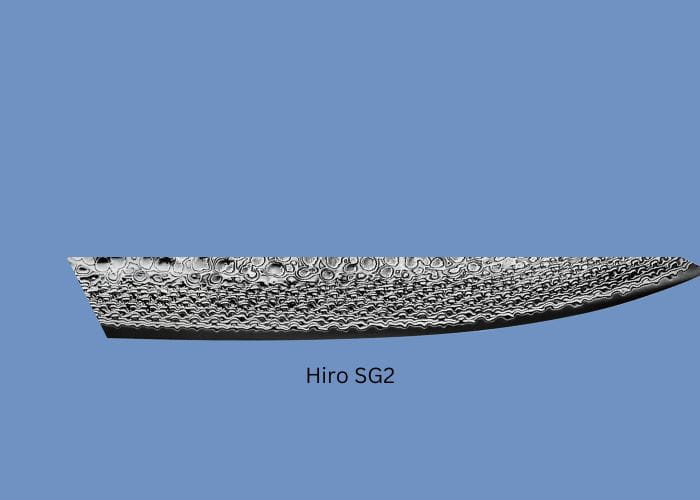
Steel Shun Knife
The Kai Corporation, and in particular Shun Cutlery, has done a great job of choosing awesome, high-end materials for their kitchen knives.
Not only do they use great materials, but they incorporate many different options into their various collections, as you saw above in our reviews of each knife line.
If you wonder why they do this, it’s because it allows them to reach different customers with different needs.
A professional cook needs professional tools, he also knows how to take care of them and can afford to buy the best ones.
On the other hand, the average home cook likes to have nice, sharp knives, but can’t afford to pay $300 per knife. Nor are they going to use and wear them out as much.
That’s why Shun offers a family of low-end steel knives to keep costs down. Since this client won’t be using the knife as often, a blade that won’t hold the edge as well doesn’t matter as much.
Here is a detailed list of the steels that Shun typically uses in the core of their blades and what makes each one special and unique.
Types of steel used to make Shun knives
AUS-10A
It is a high-carbon stainless steel (1.1% carbon) which has good corrosion resistance, hardness and wear characteristics. AUS-10A contains additional vanadium which increases strength by producing a fine-grained steel during the heat treatment process. This helps the knife take a thin edge.

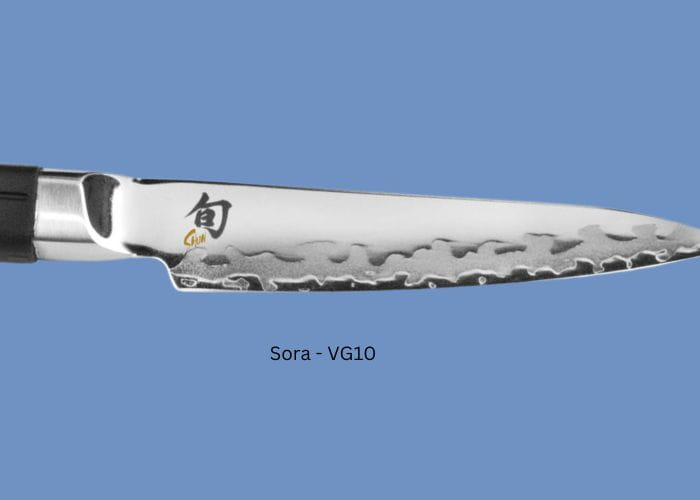
VG10
The VG10 “Super Steel” is very similar to the AUS-10A. It is also a high-carbon stainless steel (1% carbon). It is strong, has a thin edge and is stain resistant. Technically, VG10 is composed of 1% carbon, 1% molybdenum, 15% chromium, 0.2% vanadium and 1.5% cobalt. The vanadium allows for a thin steel structure, which gives Shun a durable, yet extremely sharp edge.
VG2/VG10
Shun’s Dual Core knife collection uses this combination in a folded Damascus pattern. These two high-carbon stainless sheets of steel are used in an alternating layer pattern.
It gives the blade unique characteristics, both aesthetically and in terms of performance. As the steel will wear at different rates, the blade will develop micro-serrations which will help maintain the edge over time.

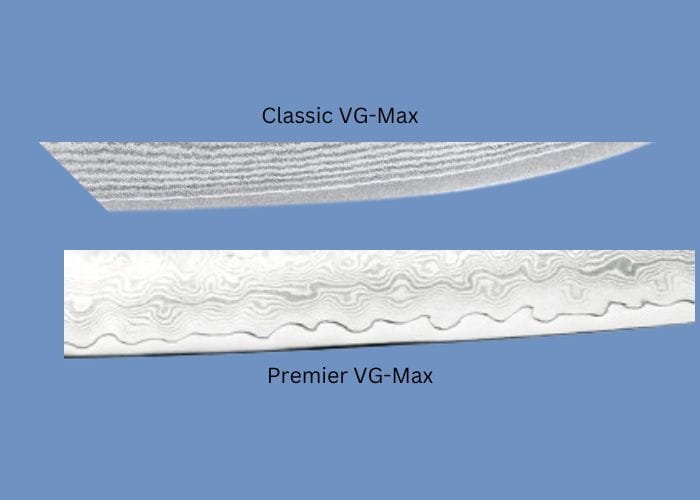
VG-MAX
This is a patented knife steel that Shun uses in its Classic and Premier series knives. It is the latest in the “VG” series and it contains more carbon to improve its resistance. It is slightly better in wear resistance and edge retention than previous versions of these “Super Steels”. It’s a great option for home cooks because it’s easy to take care of at home.
SG2 steel used in Shun knife
The SG2 is slightly different from the other steels on this list. It is said that a box of steel powder can be made to be very hard (like 64 HRC).
This gives it the ability to hold a very narrow-angle and therefore a thin blade, while remaining sharper than other steels. It is also easy to take care of it at home. So, although it is a bit more expensive, it is also a better-performing product.

Blue Steel
The Blue Steel of the Blue Series Shun Knives is a core of high-carbon steel sandwiched between two layers of stainless steel. I have planned a nice sharp edge and a particularly fast resharpening. However, due to the lack of rust protection, these knives will need extra care to protect the cutting edge from moisture and corrosion. Shun recommends their “Knife Care Kit” for that extra protection.
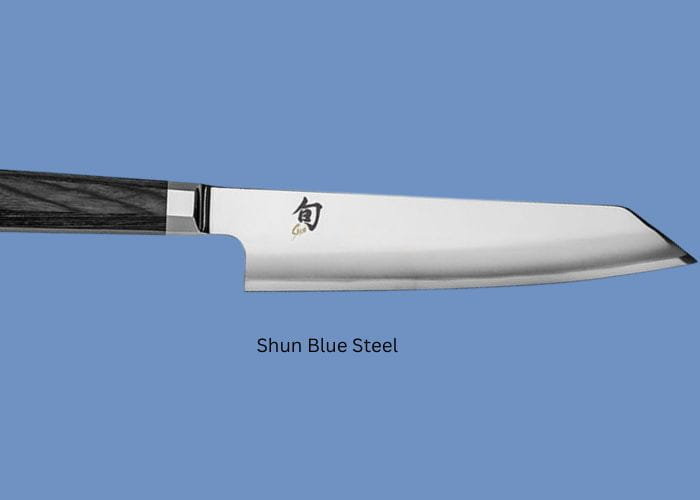
Comparison of Shun knives
It’s not uncommon when talking about Shun knives that someone asks which one is the best.
With so many options, collections, materials, processes, etc., it can be difficult to decipher what you still need or even want.
The Cut Bolt team has found that these comparisons are the most requested when it comes to Shun knives. In order to help our readers, we have compiled a brief comparative study for each subject.
We hope that comparing each series will help you make a purchase decision between two great kitchen knives.
Shun Classic vs Premier
The Shun Classic vs Premier fight pits two of the most popular Shun knife lines against each other. Both are great knives in their own right. There are many similarities in the quality of these great knife collections, but also a few things that set them apart from each other.
Similarities between Classic and Premier
First, both use Shun’s proprietary VG-MAX steel for their cutting core, as mentioned above. It is ultra-hard and ideal for wear resistance and edge retention.
Both are wrapped in 34 layers of Damascus stainless steel coating to add corrosion resistance and are sharpened to a 16 degree angle on either side of the blade.
Both lines have been around for several years, so there are plenty of knife options to choose from in each collection, including several great sets of knife blocks.
Both of these knives are really, really good looking and neither is the low-end option for the Shun (which is still high-end). Here are examples of our favorite Shun Classic and Shun Premier knife options.
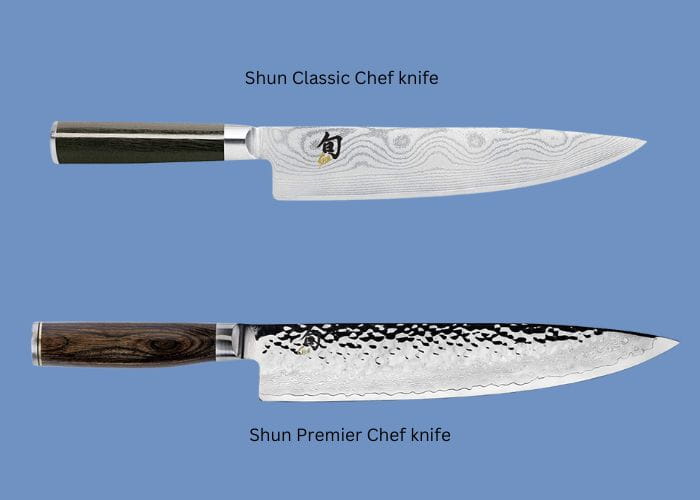
Differences between Classic and Premier Knives
Although there are many similarities between these collections, there are also characteristics that make each of them stand out from the others.
One of the first things you’ll notice if you pick them both up will be the blade finish. Although they both use VG-MAX steel for the cutting core and both are wrapped in bent Damascus steel, they look very different.
Premier Series knives are highly polished and have a tsuchime hammered finish. Sure, it looks good, but it also serves functional purposes. Much like the grantons or dimples cut into the side of some blades, the hammered finish reduces drag.
In addition to the finish, the handles are also very different, both in finish and in shape. While the Shun Classic and Premier knives both use a pakkawood handle, the Classic has an ebony colored finish and the Premier has a lighter walnut look.
As for the shape, the Classics use an asymmetrical D-shape, specially designed for right-handed chefs.
While the Premier knives are completely symmetrical and offer the same comfort for right-handed and left-handed people.
Conclusion – Shun Classic va Shun Premier knife
So what is the best Shun knife?
It is clear that both options are excellent.
In our opinion, there are two deciding factors when comparing and contrasting Shun’s Classic knives with their Premier knives.
The first and easiest thing to consider is whether you are right-handed or left-handed. If you’re left-handed, the Premier series is probably the best choice without giving it a second thought. If you are right-handed like the majority of the world’s population, the decision should be limited to aesthetics. Which do you like the most?
Performance-wise, the two are pretty much identical, with a slight nod to the Premier for its hammered finish that reduces food sticking. For this reason, we’re going to give a nod to Shun’s Premier Series!
Shun Sora vs. Shun Classic knife
This match-up, Shun Sora vs Classic, is a comparison between Shun’s most affordable line of knives and their most popular!
If you want to buy Shun family knives and don’t have the money for the “big boys”, you can almost certainly start with the Sora series of knives, prices for which start around $35 for one paring knife.
For comparison, there are plenty of Shun Classic paring knife options, but the starting price is about twice as much as the Sora, and then it goes up.
Sora vs classic similarities
There are only a few similarities between the Sora and Classic knives. Like all knives produced by Shun, they are both traditionally handcrafted by the Kai Corporation. Here is a picture comparing their 8″ chef knives.
As you can see they are both Japanese style chef knives and their handle is dark in color, but you can see right away that the handles are made of different materials, have different shapes and even the blades present different motives.
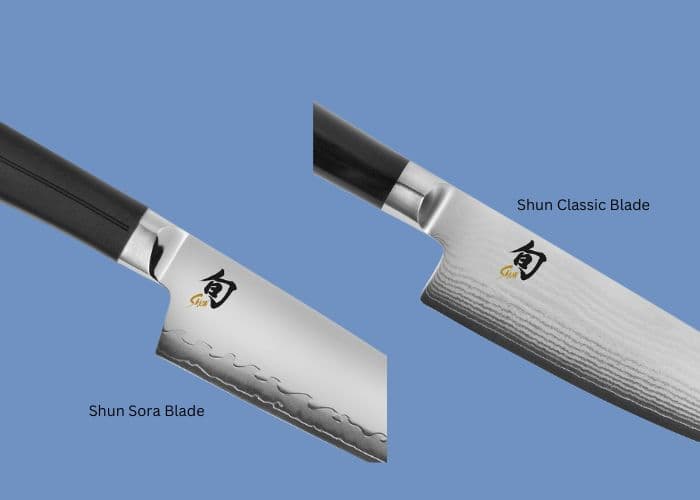
Differences between Sora and Classic kitchen knives
It is logical that if there are few similarities, there will be several differences. The first thing that strikes us is the handles.
Although they are both dark in colour, the Sora handle is a “weird ball” in the Shun range as it is made of a textured PP/TPE polymer blend, giving it a more modern look.
Those unfamiliar with the asymmetrical D-shaped handles of many Japanese knives may also find Sora handles closer to what they are used to and more comfortable.
You don’t have to be a rocket scientist to see the difference between the blades of Shun Sora knives and regular knives.
One look at the detailed photo of the blades below and you can see how different they are. The Sora uses a patented composite blade.
The use of a VG10 cutting edge and a Japanese 420J stainless steel shank provides a hard-cutting surface to maintain a beautiful edge.
It also provides a mostly corrosion-resistant blade so that it is easily maintained at home. At its price, this is where most of Shun’s Sora knives are likely sold. They are assembled by a brazing welding process.
As you already know from above, the classic Shun blade uses a VG-MAX core, wrapped in Damascus stainless steel for corrosion resistance.
Its materials are significantly more premium (both the steel of the blade and the handle) than those used in the Sora collection.
Conclusion: Shun Sora vs Shun Classic knife
It’s probably clear here that the Shun Classic series is a better knife than the Sora. But, in this comparison, the price must be taken into consideration. For anyone looking to buy their first Shun knife to see what all the fuss is about, the Sora series is the easy first step.
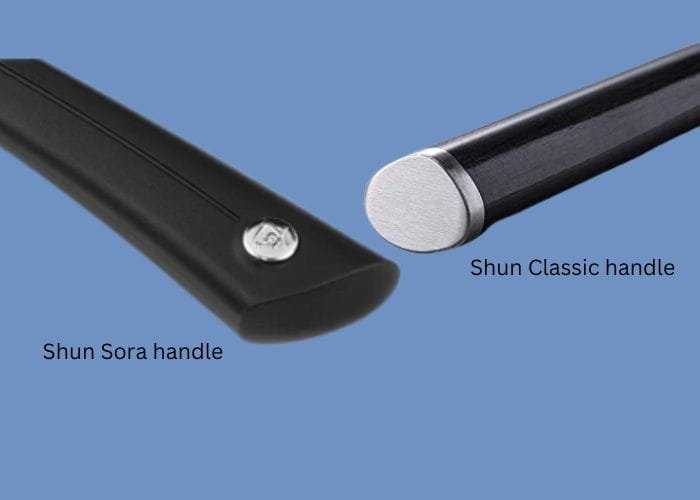
Shun knife sharpening
Shun knives, or most Japanese knives for that matter, are sharpened differently than “Western” knives found mostly in the United States.
They are thinner, harder and more fragile than the heavier blades of German knives. They also have different sharpening angles, 16 degrees is typical on Shun knives.
When it comes to sharpening Shun knives, the knife maker has three recommendations on their website.
These include sending them off for professional sharpening, self-sharpening on a grinder, and sharpening them at home with an electric sharpener.
Let’s take a look at each of them to narrow down a bit more what Shun recommends.
Return for FREE knife sharpening at Shun
Shun offers FREE sharpening on their knives. Just send them back to their facility in Tualatin, Oregon.
They even make it easy for the customer, as all they have to do is fill out this form to get started.
You’ll even have the option to purchase and print a UPS shipping label with a tracking number at a discounted price right from your computer.
You can also choose your own shipping provider, but remember it’s always a good idea to ship with a tracking number and insurance so you can guarantee your knife is well made.
This is the method we recommend for sharpening your Shun knives. There is no skill level to worry about the sharpening angle, whether you are removing too much material or leaving scratches on the surface.
It’s free.
You only need to cover the shipping costs. Unless you have time constraints or are just too scared to ship your Shun knives, consider this your best bet.
Use a whetstone
Another possibility for sharpening Shun knives if you insist on doing it yourself or if you don’t have time to wait for them to be shipped and sent back to you, use a sharpening stone at home.
NOTE: This option requires some skill and if not done incorrectly could potentially damage your knife.
Shun has its own branded whetstone for this purpose and also offers a video tutorial on the process of sharpening your Shun knife.
If you try this method and are not yet familiar with these tools, be sure to take your time and follow their instructions closely.
Use an electric knife sharpener
A third option for sharpening Shun knives is an electric sharpener. Be diligent, because not just a knife sharpener can do the job.
You will need a sharpener that uses a Shun sharpening angle of about 16 degrees to keep it as intended from the factory.
There is a Kai electric knife sharpener set to the right angle, but if you read the reviews there are mixed results with this product.
Other Shun Knife Sharpening Tips
Also on its website, Shun specifically notes that “Sharpening is not something that should be done on a weekly basis. In fact, honing removes some of the metal from the blade, so sharpening too frequently can reduce the life of your knife”.
Also, they beg all of their customers not to use a cutter with diamond or diamond grit (many electric cutters use diamond wheels). They claim that it is simply too aggressive material for their fine cutlery.
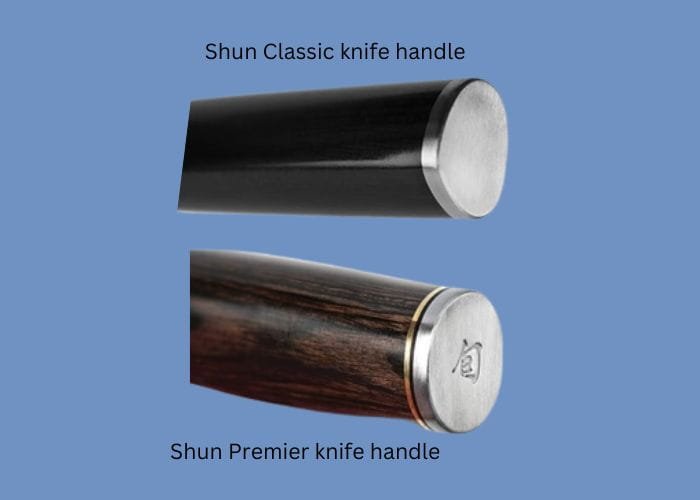
How to sharpen a Japanese knife?
As you may know, honing is different from sharpening. Honing helps maintain the blade for optimum performance and can extend its life. Unlike honing, honing keeps the microscopic edge aligned, but does not remove any material. Regular sharpening will reduce the need to sharpen your blades.
With the right tools, like the Shun Honing Steel, this process is much easier and requires less skill than sharpening. It also specifically guides you to the correct 16 degree angle.
Again, be sure not to use a diamond in this process.
“Diamond steels”, as they are often called, can strip metal from your knife. Here is a nice video tutorial from Shun for sharpening their knives as mentioned above.
Warranty on Japanese Shun knives
Shun knives are backed by a limited lifetime warranty. Per Shun, the warranty protects “against manufacturing defects in materials and construction and to perform as advertised when properly used and maintained.”
Note that the warranty is non-transferable and lasts for the life of the original owner. Like most warranties, it does not cover normal wear and tear, damage due to improper maintenance or misuse, accidents or loss/theft.
How to clean Shun knives?
Also, the Shun warranty does not cover rust or corrosion on the blade. Why this question?
Well, because it’s your responsibility to maintain them. And part of caring for good high-carbon knives includes not soaking them in water and rinsing and drying them by hand immediately after use.
Do not use soaps or detergents as they can promote corrosion.
It is also not advisable to use scouring pads as they may scratch the finish of the blades. Just rinse and towel dry immediately after use…by hand.
Are Shun knives dishwasher safe?
It is NOT RECOMMENDED to wash your Shun knives in the dishwasher. There are several reasons for this. For one, they have thin, fragile blades that can chip it; they are struck or struck. In addition, the dishwasher can leave them damp for long periods of time or use harsh detergents, which promotes unnecessary corrosion.
Conclusion – Are Shun Knives worth it?
Shun Cutlery and the Kai Corporation makes some amazing knives. They are both beautiful and efficient thanks to the traditional processes and high-quality materials used in their production.
Unlike many new kitchen knife brands, Shun knives are not mass-produced, but rather handmade, functional works of art that take craftsmen many hours to produce.
With that in mind, it’s no wonder that Shun knives are some of the most popular kitchen knives in the world.
There really isn’t a discussion of Japanese knives that don’t include Shun cutlery.
Very few consumers who decide to purchase Shun knives are disappointed, as evidenced by the countless positive reviews posted online.
This is just more social proof that their knives are great, but if you read this entire guide, you know the knives are great!

